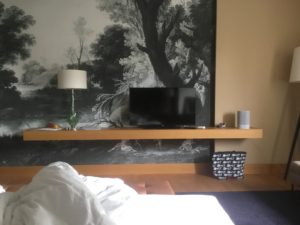Neulich hörte ich mir das Gespräch zwischen Brian Eno und Rick Rubin an, in dem Eno quer durch sein Schaffen befragt wurde, und natürlich auch einige „Repertoire-Stories“ erzählte, unter anderem, wie sehr ihn in der Kindheit die Gitterbilder von Mondrian berührten, als er ihnen das erste Mal begegnete, und wie etwas so Minimalistisches einen so immensen emotionalen Eindruck hinterlassen konnte. Genau diesen Aspekt verfolgte er ja auch mit etlichen seiner Alben. Was ich nicht wusste: er erzählte Rick Rubin auch, dass er als Kind unendlich viele Bilder malte, in denen Rot und Blau sich vermischten, weil ihn diese Zwischenzone (nennen wir es violett, es gibt sicher noch andere Namen) besonders faszinierte. Als hätte er irgendwann, bewusst oder unbewusst, den Entschluss gefasst, das Blau und das Rot der Mondrian-Bilder aus ihren schwarzen Umrandungen bzw. Einkastelungen zu lösen, zu befreien, um eine andere Zwischenwelt zu erforschen. „Instead of clarity / The colors of rain / Bittersweet wooziness / What a romance“, ruft E.E. Cummings in einem berühmten Gedicht aus. Ein kreativer Akt, auch wenn meines Wissens keines dieser frühen Bilder erhalten geblieben ist, oder von besonderer Bedeutung gewesen wäre, ausser eben, einer ganz eigenen Fantasie auf die Sprünge zu helfen. Auch in seiner Ambient Music werden ja Sounds aus gewohnten Begrenzungen von Zeitmass und Melodie gelöst! Ich erinnere mich auch, wie Brian, als ich ihn nach seiner frühen Kindheit befragte, von seinem Grossvater erzählte, der in einer ehemaligen Kapelle lebte, in der ein Priester Suizid begangen hatte. Und die Räume waren, statt von Tapeten, von Orgelpfeifen umstellt, so dass man dort immerzu von (der Vorstellung von) Klängen umgeben war. Schon dieser Raum der frühen Kindheit versinnbildlicht die Idee der „Ambient Music“, lang bevor Brian im Krankenhaus, ans Bett gefesselt, die viel zu leisen Klänge walisischer Harfenmusik hörte, sie sich mit dem Licht des Tages und dem Regen mischten.
